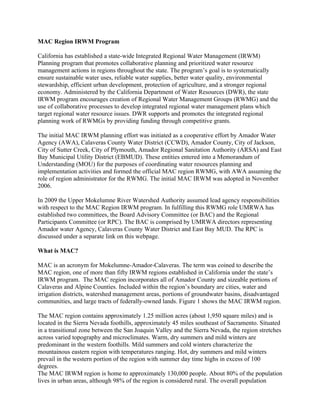
MAC Region IRWM Program
- 1. MAC Region IRWM Program California has established a state-wide Integrated Regional Water Management (IRWM) Planning program that promotes collaborative planning and prioritized water resource management actions in regions throughout the state. The program’s goal is to systematically ensure sustainable water uses, reliable water supplies, better water quality, environmental stewardship, efficient urban development, protection of agriculture, and a stronger regional economy. Administered by the California Department of Water Resources (DWR), the state IRWM program encourages creation of Regional Water Management Groups (RWMG) and the use of collaborative processes to develop integrated regional water management plans which target regional water resource issues. DWR supports and promotes the integrated regional planning work of RWMGs by providing funding through competitive grants. The initial MAC IRWM planning effort was initiated as a cooperative effort by Amador Water Agency (AWA), Calaveras County Water District (CCWD), Amador County, City of Jackson, City of Sutter Creek, City of Plymouth, Amador Regional Sanitation Authority (ARSA) and East Bay Municipal Utility District (EBMUD). These entities entered into a Memorandum of Understanding (MOU) for the purposes of coordinating water resources planning and implementation activities and formed the official MAC region RWMG, with AWA assuming the role of region administrator for the RWMG. The initial MAC IRWM was adopted in November 2006. In 2009 the Upper Mokelumne River Watershed Authority assumed lead agency responsibilities with respect to the MAC Region IRWM program. In fulfilling this RWMG role UMRWA has established two committees, the Board Advisory Committee (or BAC) and the Regional Participants Committee (or RPC). The BAC is comprised by UMRWA directors representing Amador water Agency, Calaveras County Water District and East Bay MUD. The RPC is discussed under a separate link on this webpage. What is MAC? MAC is an acronym for Mokelumne-Amador-Calaveras. The term was coined to describe the MAC region, one of more than fifty IRWM regions established in California under the state’s IRWM program. The MAC region incorporates all of Amador County and sizeable portions of Calaveras and Alpine Counties. Included within the region’s boundary are cities, water and irrigation districts, watershed management areas, portions of groundwater basins, disadvantaged communities, and large tracts of federally-owned lands. Figure 1 shows the MAC IRWM region. The MAC region contains approximately 1.25 million acres (about 1,950 square miles) and is located in the Sierra Nevada foothills, approximately 45 miles southeast of Sacramento. Situated in a transitional zone between the San Joaquin Valley and the Sierra Nevada, the region stretches across varied topography and microclimates. Warm, dry summers and mild winters are predominant in the western foothills. Mild summers and cold winters characterize the mountainous eastern region with temperatures ranging. Hot, dry summers and mild winters prevail in the western portion of the region with summer day time highs in excess of 100 degrees. The MAC IRWM region is home to approximately 130,000 people. About 80% of the population lives in urban areas, although 98% of the region is considered rural. The overall population
- 2. density is 2000 people per square mile (the average for the entire region), with rural areas having a population density of about 40 people per square mile. The primary sources of water in the region are the Mokelumne and Calaveras River watersheds (and to a lesser extent, the Cosumnes River watershed), with snowmelt and rainfall from the Sierra Mountain Range transported via the rivers and their tributaries. Although the region is famous for its historic gold mining and recreation, current land uses also include cattle ranching, orchards, timber, vineyards and row crops, and mining (industrial minerals, limestone, sand and gravel). Development in the MAC Region, both urban and rural, is clustered around the major cities and highways. Agriculture, grazing, and open spaces dominate land uses and represent a relatively large portion of the total region land use. Other industries outside the urban setting include mining and timber harvesting where the majority of the land cover is forest, shrub and grassland. General land use trends in the region include significant development of rural and agricultural areas associated with population increases in Plymouth and Sutter Creek (Amador County), Kirkwood and Bear Valley (Alpine County), and the Rancho Calaveras and La Contenta areas (Calaveras County). A second land use trend is a shift from grazing to viticulture and viticulture to residential development. FIGURE 1: